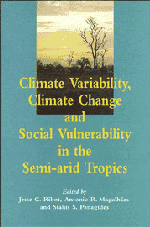Book contents
- Frontmatter
- Contents
- List of contributors
- Foreword by Tom Downing
- Preface
- List of abbreviations
- Introduction. Climate Variability, Climate Change and Vulnerability: Moving Forward by Looking Back
- PART I OVERVIEW
- PART II CLIMATE VARIATION, CLIMATE CHANGE AND SOCIETY
- PART III CLIMATE VARIABILITY AND VULNERABILITY: CAUSALITY AND RESPONSE
- 6 Drought Follows the Plow: Cultivating Marginal Areas
- 7 Amazonia and the Northeast: The Brazilian Tropics and Sustainable Development
- 8 Reducing the Impacts of Drought: Progress Toward Risk Management
- PART IV THE INTERNATIONAL CONFERENCE ON THE IMPACTS OF CLIMATIC VARIATIONS AND SUSTAINABLE DEVELOPMENT IN SEMI-ARID REGIONS (ICID)
8 - Reducing the Impacts of Drought: Progress Toward Risk Management
Published online by Cambridge University Press: 02 December 2009
- Frontmatter
- Contents
- List of contributors
- Foreword by Tom Downing
- Preface
- List of abbreviations
- Introduction. Climate Variability, Climate Change and Vulnerability: Moving Forward by Looking Back
- PART I OVERVIEW
- PART II CLIMATE VARIATION, CLIMATE CHANGE AND SOCIETY
- PART III CLIMATE VARIABILITY AND VULNERABILITY: CAUSALITY AND RESPONSE
- 6 Drought Follows the Plow: Cultivating Marginal Areas
- 7 Amazonia and the Northeast: The Brazilian Tropics and Sustainable Development
- 8 Reducing the Impacts of Drought: Progress Toward Risk Management
- PART IV THE INTERNATIONAL CONFERENCE ON THE IMPACTS OF CLIMATIC VARIATIONS AND SUSTAINABLE DEVELOPMENT IN SEMI-ARID REGIONS (ICID)
Summary
INTRODUCTION
Images of malnutrition, famine and a degraded African landscape were commonplace during the 1980s and appear likely to continue well into the 1990s and beyond. Glantz (1987) has shown that drought has hindered the ability of much of sub-Saharan Africa to achieve a sustained level of agricultural production and, as a result, has retarded progress toward economic development. Linkages between drought and economic development, although most obvious in Africa, exist throughout much of the developing world.
The impacts of drought in developed countries differ substantially from those experienced in much of the developing world. Absent are the widespread occurrences of food shortages, which may lead to malnutrition and famine, and large-scale evidence of land degradation. However, economic costs, particularly in the agricultural, energy and transportation sectors, are substantial. The recent droughts in the United States and Canada have been stark reminders of the vulnerability of all nations to this extreme climatic event. This increased awareness of the economic, social and environmental costs of drought is leading a growing number of nations, both developed and developing, to seek a more proactive approach to drought management. These nations now realize that they can no longer afford to divert scarce financial resources to drought relief programs that do little to reduce, and may actually increase, vulnerability to subsequent periods of water shortage.
The purpose of this chapter is to present a case study of the recent progress that has been made by some countries in reducing their vulnerability to drought. Progress toward drought preparedness will be discussed for the United States of America, South Africa, and Australia.
- Type
- Chapter
- Information
- Climate Variability, Climate Change and Social Vulnerability in the Semi-arid Tropics , pp. 147 - 164Publisher: Cambridge University PressPrint publication year: 1996

